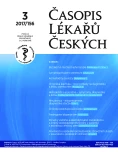The sanctuaries of Asklepios in ancient Athens
Authors:
Tomáš Alušík 1; Pavla Alušíková Dostalíková 2
Authors‘ workplace:
Ústav dějin lékařství a cizích jazyků 1. LF UK
1; České centrum pro středomořskou archeologii, z. s.
2
Published in:
Čas. Lék. čes. 2017; 156: 160-162
Category:
History of Medicine
Overview
Asklepios was the main healing deity of the Classical Antiquity. After his gradual establishing, his cult expanded throughout the Greek world especially in the 5th century BC, when Asklepios reached also Athens. Around 420 BC, two sanctuaries of his (sc. Asklepieia) were founded there. Such sanctuaries were places of both the worship and therapy. The first one was located in the port of Pireus, the second one on the south slope of the Acropolis. The latter functioned as a centre of the healing cult almost until the end of the 5th century AD. Sometime in the 1st half of the 6th century a Christian basilica was built over the area of the earlier buildings of Asklepieion.
Keywords:
Asklepios , Asklepieion , Athens , Antiquity
Sources
1. Kerényi K. Mytologie Řeků I: Příběhy bohů a lidí. Oikoymenh, Praha, 1996.
2. Lambrinoudakis VK. Theurgic medicine. In: Stampolidis NC, Tassoulas Y (eds.). Hygieia: health, illness, treatment from Homer to Galen. Museum of Cycladic Art – Hellenic Ministry of Culture and Sports, Athény, 2014: 17–31.
3. Canfora L. Dějiny řecké literatury. KLP, Praha, 2001.
4. Homéros. Ílias (přeložil Otmar Vaňorný). Petr Rezek, Praha, 2007.
5. Homérské hymny. Válka žab a myší (přeložil Otakar Smrčka). Státní nakladatelství krásné literatury, hudby a umění, Praha, 1959.
6. Walton A. The Cult of Asklepios. Ginn & Co., Boston, 1894.
7. Kerényi K. Asklepios: Archetypal image of the physician's existence. Pantheon Books, New York, 1959.
8. Riethmüller JW. Asklepios: Heiligtümer und Kulte. Verlag Archäologie und Geschichte, Heidelberg, 2005.
9. Wickkiser BL. Asklepios, Medicine, and the Politics of Healing in Fifth-Century Greece. Between Craft and Cult. JHU Press, Baltimore, 2008.
10. Ananiades D. Ancient Greece. Temples and Sanctuaries. Toubi’s Editions, Athens, 2010.
11. Iakovidis SE. Mycenae-Epidaurus. Argos-Tiryns-Nauplion. A complete guide to the museums and archaeological sites of the Argolid. Ekdotike Athenon S. A., Athens, 1993.
12. Hatzivassiliou VS. The Asklepion of Kos. A world heritage monument. M. Georvassakis J. S. C., Kos, 2000.
13. Kiapokas MS. Hippocrates of Cos. Heptalophos S. A., Athens, 2003.
14. Aleshire SB. Asklepios at Athens: Epigraphic and prosopographic essays on the Athenian healing cults. J. C. Gieben, Amsterdam, 1989.
15. Travlos J. Pictorial dictionary of ancient Athens. Thames and Hudson, London, 1971.
16. Camp JM. The archaeology of Athens. Yale University Press, New Haven, London, 2001.
17. Kavvadias G, Giannitrapani E (eds.). South slope of the Acropolis. Brief history and tour. Hellenic Ministry of Culture.
Labels
Addictology Allergology and clinical immunology Angiology Audiology Clinical biochemistry Dermatology & STDs Paediatric gastroenterology Paediatric surgery Paediatric cardiology Paediatric neurology Paediatric ENT Paediatric psychiatry Paediatric rheumatology Diabetology Pharmacy Vascular surgery Pain management Dental HygienistArticle was published in
Journal of Czech Physicians

- Advances in the Treatment of Myasthenia Gravis on the Horizon
- Metamizole at a Glance and in Practice – Effective Non-Opioid Analgesic for All Ages
- Metamizole vs. Tramadol in Postoperative Analgesia
- What Effect Can Be Expected from Limosilactobacillus reuteri in Mucositis and Peri-Implantitis?
- Possibilities of Using Metamizole in the Treatment of Acute Primary Headaches
Most read in this issue
- Basal cell carcinoma and the modalities of its therapy
- Diseases affecting the scalp
- Hirsutism – etiopathogenesis, diagnostics and treatment
- Androgenetic alopecia in women
